W.G. Sebald
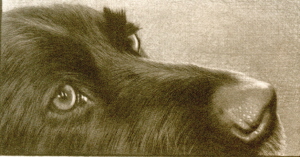
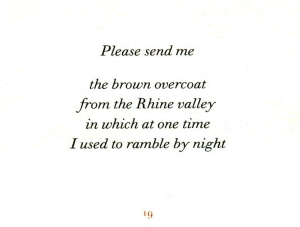
Người ghi chú cô đơn: The Solitary Notetaker.
Susan Sontag đã từng tự hỏi, trên tờ TLS, liệu "văn chương lớn" có còn không, và bà tự trả lời, còn chứ, Sebald đó.
Tuy nhiên, kể từ khi ông mất, có nhiều cái nhìn khác nhau về ông. Lớn lao, số một, giọng không giống ai, vẫn đúng đấy, nhưng đọc kỹ hơn, gần hơn, nghe ra có nhiều vay mượn. Tác phẩm của ông, có thể nói, một nửa là do uyên bác, nửa còn lại, là tưởng tượng và kinh nghiệm của riêng ông.
Nếu có một nhà văn vay mượn rất nhiều từ những nhà văn khác, nhưng vẫn là một thứ đồ zin, đồ xịn, nếu có, thì đúng là Sebald.
Charles Simic, trên NYRB điểm hai cuốn mới nhất của ông, Campo Santo, một thứ tiểu luận, và Unrecounted, gồm 33 bài thơ nho nhỏ, của ông, và 33 bức họa, của Jan Peter Tripp.
Họa: Mỗi bức là một đôi mắt, với sự chính xác, của hình chụp: Proust, Rembrandt, Beckett, Borges... Chủ đề của họa: Miệng thì tốt, để nói dối, trong khi mắt, khó nói dối. Bất cứ mắt đang mơ mộng, hay suy tư, chúng đều vọng một tí ti sự thực, nào đó. Dưới mỗi đôi mắt, là một bài thơ mini. Thí dụ, dưới cặp mắt của Maurice, chú chó của Sebald, là:
Please send
me
the brown overcoat
from the Rhine valley
in which at one time
I used to ramble the night.
[Hãy gửi cho tôi
cái áo choàng mầu nâu
từ thung lũng sông Rhine
mà có lần tôi mặc dạo đêm].
Và đây là một bài thơ mini thật thú vị:
Người ta
nói,
Nã Phá Luân mù mầu [color-blind]
Máu đối với ông ta,
thì xanh như lá cây.
Họa: Mỗi bức là một đôi mắt, với
sự chính xác, của hình chụp: Proust, Rembrandt, Beckett, Borges...
Chủ đề của họa: Miệng thì tốt, để nói dối, trong khi mắt, khó nói dối. Bất
cứ mắt đang mơ mộng, hay suy tư, chúng đều vọng một tí ti sự thực, nào đó.
Dưới mỗi đôi mắt, là một bài thơ mini.
Thơ của ông thực sự cũng khó mà gọi là thơ. Như nhà phê bình Andrea Kohler
chỉ ra, đó không phải là ngụ ngôn, mà cũng chẳng phải thơ. Chỉ là những cú
xổng chuồng, thoáng chốc, của tư tưởng, của hồi nhớ, những khoảnh khắc loé
sáng, ở mép bờ của cảm nhận.
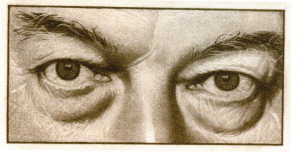
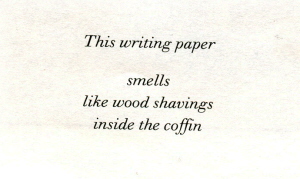
Jasper Johns
Trang giấy viết này ngửi như mùi gỗ bào trong quan tài
*
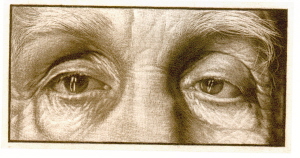
Borges
My eye
begins to be obscured Joshua Reynolds remarked
on the eve of the storming of the Bastille
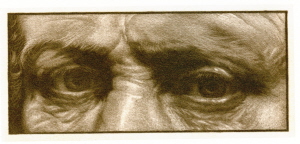
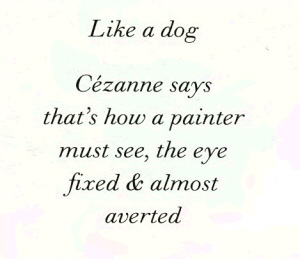
Thơ của ông thực sự cũng khó mà gọi
là thơ. Như nhà phê bình Andrea Kohler chỉ ra, đó không phải là ngụ ngôn,
mà cũng chẳng phải thơ. Chỉ là những cú xổng chuồng, thoáng chốc, của tư
tưởng, của hồi nhớ, những khoảnh khắc loé sáng, ở mép bờ của cảm nhận.
Nguyên tác cái tít tiếng Đức là một từ bất bình thường,
the unusual word ‘unerzahlt, cả
hai Sebald và Tripp
cùng chọn.
Khi dịch sang tiếng Anh, Michael Hamburger không chọn từ bình thường, là ‘untold’,
mà lại dùng từ ‘unrecounted, bởi vì theo dịch giả, ‘untold’ [chưa nói, chưa
kể], không chỉ hàm hồ, ambiguous, mà còn có nghĩa đầu tiên là ‘không thể
đếm được’, hay ‘không thể đo được’, countless or measureless. Dịch giả cũng
cho biết, nguồn của những bài thơ mini này là thơ haiku của Nhật. [“Trong
một lá thư viết cho tôi, Tess Jaray nhắc tới chuyện Max có mang theo cùng
với ông một cuốn thơ haiku Nhật, khi đem những bản văn đầu tiên này tới”.]
Hình như Barthes thì phải, trong cuốn viết về thơ haiku, [L'EMPIRE DES SIGNES (1970), cái này để check lại, vì mớ sách
của Gấu đang gặp đại họa chuyển nhà liên tục] có nhắc tới ‘tiếng vỗ của một
bàn tay’.
Bài thơ haiku nào cũng làm chúng ta liên tưởng tới điều này, hay, một điều
gì đó, vượt ra khỏi bài thơ.
Một bài haiku là một "viễn ảnh không cần còm". "Tiếng vỗ của một bàn tay", "rút
lui ra khỏi từ" [chữ của Steiner],
thì làm sao mà... lèm bèm?
L'EMPIRE DES
SIGNES (1970) was written after Barthes's visit to Japan, and
dealt with the country's myths. In this great introduction to the art of
definitions, Japanese cooking was for him "the twilight of the raw", a haiku
a "vision without commentary", and sex "is everywhere, except in sexuality."
"Đế quốc ký hiệu" được viết sau khi Barthes thăm viếng Nhật Bản, và đề cập
tới những huyền thoại của xứ sở này. Đây là một lời dẫn lớn lao, về nghệ
thuật của những định nghĩa, việc nấu nướng của Nhật đối với ông, là "chạng
vạng của cái sống, cái còn nguyên", một bài hai ku là một "viễn ảnh không
cần lèm bèm về nó", và sex thì "ở khắp nơi, trừ ở dục tính".
Wikipedia
Bài thơ con
cóc, dở, chứ không thể hay được, là vậy. Nó trần trụi, trơ ra, con cóc trong
hang, con cóc nhảy ra, con cóc ngồi đó… Khó mà tưởng tượng ra được tiếng vỗ
của hai bàn tay, chứ đừng nói một!
Đừng có nghĩ Gấu nhắm 'gâu gâu' nhà đại phê bình, mà đây là chuyện đàng
hoàng, nghiêm túc!
Ngay cả khi ông đại phê bình gọi Gấu bằng chó, thì chắc là ông không bao
giờ tưởng tượng ra được, Milosz đã vinh danh chó như thế nào trong cuốn Chó
Bên Đường của ông, (1) và Sebald, ở đây, với những dòng haiku 'phụ đề' cho
đôi mắt Rembrandt:
'Like
a dog / Cezanne says / that's how a painter / must see, the eye / fixed &
almost / averted.' Jan Peter Tripp
has juxtaposed these lines with the shaded eyes of Rembrandt. The lines allude
to a little text by Tripp about Things, but the dog runs into this book straight
out of earlier pictures by Jan Peter Tripp. As a 'bearer of the secret' who,
as Sebald writes in his essay on the painter, 'runs with ease over the abysses
of time', a dog, he writes, knows 'many things more accurately than we do.
His left (domesticated) eye is attentively fixed on us; the right (wild)
one has a little less light, strikes us as averted and alien. And yet we
sense that it is the overshadowed eye that sees through us.'
Mấy dòng haiku “Like a
dog…“, nếu không dẫn giải, thật khó mà hiểu được, nhưng khi dẫn giải ra được,
thì hình như là nói cạnh nói khoé Gấu, thằng mắt lác, "mắt nọ chửi bố mắt
kia", hay, "một mắt nhìn cô dâu, một mắt nhìn cô phù dâu", như Gấu Cái sau
này vẫn thường nhớ lại bữa rước dâu từ Cai Lậy về Sài Gòn.
“Như một con chó/ Czéanne nói/một họa sĩ phải
nhìn như thế, một mắt/chăm chú & hầu như/lảng tránh”. Tripp trộn
những dòng thơ với đôi mắt u tối của Rembrandt. Những dòng thơ này muốn nhắc
tới một bài viết nho nhỏ của Tripp về Những Sự Vật, nhưng con chó thì chạy
thẳng vào trong cuốn sách, từ những bức vẽ trước đó của Tripp. Như là ‘một
người mang niềm bí ẩn’, Sebald đã từng, trong một tiểu luận, viết về họa
sĩ, người ‘chạy dễ dàng bên trên vực thẳm’, một con chó, ông viết, ‘biết
rất nhiều điều chính xác hơn chúng ta’. Mắt trái [thuần hoá] của nó thì chăm
chú nhìn chúng ta, mắt phải [hoang dại] thì không sáng bằng mắt trái, hầm
hè nhìn chúng ta, như muốn lảng tránh, và xa lạ. Tuy nhiên, chúng ta cảm
nhận ra, đây là con mắt u tối nhìn thấu suốt chúng ta”
(1)
Chó Bên Đường
Tôi làm một chuyến đi, để tự mình làm quen với xứ sở của tôi, trên một chiếc
xe hai ngựa, với rất nhiều cỏ khô, và một xô nước uống cho ngựa, ở phiá sau
xe. Tôi đi qua một vùng đồi, hai bên đường là những nhóm cây thông, con đường
dẫn tới một vùng rừng, với những mái rạ lấp ló, ẩn hiện sau lùm cây, và từ
mái rạ, những tụm khói bốc lên khiến có cảm tưởng đó là những căn nhà đang
cháy. Tôi đi qua những vùng đồng, vùng ao hồ. Thật là thú vị khi cứ đi như
thế, mặc tình cho ngựa rong ruổi, và chờ đợi, khi, vượt thung lũng tới, và
lại nhìn một làng quê từ từ xuất hiện, hay một công viên, với một điểm trắng
của một trang viện ở trong nó. Và đi tới đâu, bất cứ chỗ nào, chúng ta cũng
nghe tiếng chó sủa. Con vật tỏ ra hết sức trung thành, hết sức mẫn cán, với
nhiệm vụ của nó. Đó là khởi đầu của thế kỷ. Đó là chấm dứt của thế kỷ.
Tôi không chỉ nghĩ đến những con người sống ở đó, bao nhiêu thế hệ con người,
mà còn nghĩ tới bao nhiêu thế hệ chó, đời đời kiếp kiếp chó, cùng rong ruổi
với con người, trong cái cuộc đời một ngày như mọi ngày. Và thế là một cái
tên bật ra, vào lúc tảng sáng, trước khi lại ngủ trở lại, tự nó gói ghém
hết ý nghĩa của nó: Chó Bên Đường.
*
Trong Empire of Signs, Barthes có vài bài
về thơ haiku. Tin Văn sẽ post và lèm bèm về haiku, và về bài thơ dởm Con
Cóc mà nhà đại phê bình khen hay thật là hay!
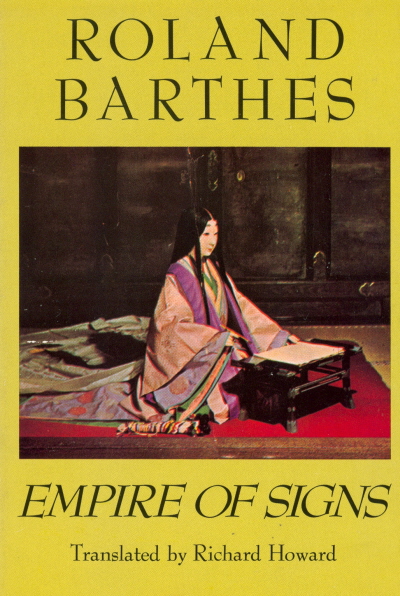
"If Japan did not exist, Barthes would have had
to invent it - not that Japan does exist in Empire of Signs, for Barthes
is careful to point out that he is not analyzing the real Japan but rather
one of his own devising. In this fictive Japan, there is no terrible innerness
as in the West, no soul, no God, no fate, no ego, no grandeur, no metaphysics,
no 'promotional fever' and finally no meaning ... For Barthes Japan is a
test, a challenge to think the unthinkable, a place where meaning is finally
banished. Paradise, indeed, for the great
student of signs."
-Edmund White
The New York Times Book Review
Nếu không có Nhật
Bản, thì Barthes sẽ phịa ra nó. Nhưng nước Nhật ở trong Đế Quốc Ký Hiệu cũng không thực, như
Barthes cẩn trọng nói với chúng ta là, ông không nghiên cứu nước Nhật thực,
mà là một nước Nhựt của riêng ông, do ông ‘chế’ ra. Trong cái nước Nhựt giả
tưởng này, thì không hề có cái "bên trong" khủng khiếp như là ở Tây phương.
Không linh hồn, tâm hồn, không Thượng Đế, không số mệnh, không cái tôi, không
vinh quang, không đỉnh cao, không siêu hình, không “cơn sốt lên lương, lên
chức, vô Đảng, vô BCT” và sau cùng, không có cái gọi là ý nghĩa.
Với Barthes, Nhật Bản là một thí nghiệm, một thách đố để suy nghĩ về cái
không thể suy nghĩ, một nơi chốn mà ý nghĩa thì sau cùng bị loại trừ. Thiên
đường, thực sự là vậy, cho một tay sinh viên lớn, về ký hiệu.
The Observer
The eyes have it
Nearly three years on from his death, WG Sebald has become a huge cult figure. His last book, a collaboration with the German artist Jan Peter Tripp, is a haunting testament to his singular and lasting vision
Tim Adams
Sunday 19 September 2004 01.10 BST
At the end of the opening story of The Emigrants , the first of his books to be published in this country, WG Sebald wrote a line that was something of a statement of intent: 'And so they are always returning to us, the dead.' In his case, that observation is proving true. Nearly three years after the car crash that ended his life at the age of 57, new books by Sebald continue to emerge. The latest, Unrecounted, the result of a long collaboration with a childhood friend, German artist Jan Peter Tripp, is suitably haunting.
It has often been said that, in his brief, marvellous career, Sebald, writing from East Anglia, invented a genre all his own. The substance of that originality was a new way of looking at what remains of long-gone objects, people and events. All his books were imaginative exhumations, but they were given a curious urgency by his inspired and restless intelligence. His writing made the dead seem like news.
In Austerlitz, the most profound statement of this method, Sebald wrote of his sense that the dead were more real than the living. It was the belief of his hero, Austerlitz, who had escaped the Holocaust on a kindertransport, that 'time did not exist at all, only various spaces interlocking according to the rules of a higher form of stereometry, between which the living and the dead can move back and forth as they like, and the longer I think about it the more it seems to me that we who are still alive are unreal in the eyes of the dead, that only occasionally, in certain lights and atmospheric conditions, do we appear in their field of vision'.
It was something like this sense that attracted Sebald to the work of Jan Peter Tripp. They shared a past - they both grew up in Bavaria just after the war - that understood a good deal about destruction and loss. (Until he was in his teens, Sebald believed that all cities were ruins.) On his frequent trips to the Continent, Sebald visited the artist in Alsace and encountered something of the same sense of absence and dislocation he felt in himself. On some of these visits, they developed an idea that they would make a book together exploring the places where their vision overlapped.
Sebald described Tripp's work as taking realism to 'an almost unimaginable extreme'. For the book they planned, the artist took and found photographs of the eyes of a number of people they both knew or admired and made disconcertingly exact etchings and lithographs from them. At a glance, you imagine these eyes to be photographs and, when you are realise they are not, you stare at them as if in search of a clue to their composition. They seem both unreal and more than real; they have a life of their own. In an essay about Tripp's work, Sebald talked of 'the role of the observer and the observed objects being reversed. Looking, the painter relinquishes our too-facile knowingness; unrelatedly, things look across to us.'
Michael Krüger, the German publisher of Sebald, remembers the pair of them coming into his office to propose the idea for their book, two schoolfriends, excitedly explaining a project. 'Max [Sebald] talked a lot about looking, about the little pieces he would write about looking. Some of the pieces would be old, some new, but they would all be about the way we viewed the world.' While Sebald was talking, Tripp stood up and started taking photographs of Krüger. 'We will, of course, have to include your eyes in the book, too,' he explained. Tripp's subsequent etching of the publisher's eyes carries with it a typical fragment of Sebald's verse, what he called a 'micropoem': 'They say / that Napoleon / was colourblind / & blood for him / as green as / grass.'
When Sebald died, Tripp put the 33 images he had made together with Sebald's haikus. The eyes that stare at you from their letterbox frames are, thus, like memorial stones to a curious friendship. They include writers and painters they had discussed - William Burroughs and Francis Bacon, Rembrandt and Truman Capote - as well as family and mutual friends, like Krüger. The result is a primer for Sebald's other work, which was always concerned with the befores and afters of photographs, the way writing revives the life that the still image has frozen. In The Emigrants, he likened this to a fascination with the traces skaters leave behind in the afternoon sun.
In the last interview before his car crash, just as he was finalising the translation of Unrecounted, Sebald pointed to a small boy in an old family photograph on his office wall and explained how the boy 'returned from the First World War mentally disturbed after electric shock therapy. This is before he knew. I find that frightful: the incapacity to know what's round the corner.'
The most powerful of the pictures in Unrecounted, in this respect, is that of Anna Sebald, the writer's daughter, who was in the car with her father when he died, and who suffered severe injuries. Tripp's etching, made before the accident, seems now to carry all the horror of the moment that was to come. The knowledge of what was around the corner. Eyes which once might have looked innocent, or hopeful, are now freighted with unimaginable hurt.
In life, Sebald was obsessed by this temporal property of pictures. 'It was,' says Michael Krüger, 'a strange thing to wander in a city with Max, in that he always had his camera to hand. He would sometimes stop every few paces and take a picture. Always trying to capture and preserve something he had seen.' Susan Sontag, who described Sebald as 'the contemporary master of the literature of lament and mental restlessness', has suggested to Krüger that the hundreds of thousands of archived photographs Sebald left behind be edited into a book, a lasting memorial to his vision, his way of seeing.
Krüger says that Unrecounted might be seen as a kind of brief prologue to that work, but that collating the photographs - undated and uncaptioned - will be a monumental task. 'Some of them are easier, like when he was walking in Suffolk for his book, The Rings of Saturn. For most, though, you have absolutely no idea where you are, what you are seeing, except that you know this thing was once important to Max.'
All great writers invite you to see the world through their eyes but few have offered such an indelible vision as Sebald. Tripp's last etchings in the book are, appropriately, two pictures he made of Sebald's eyes, now looking back from across the divide of death, along with another little fragment from the writer: 'At the end / only so many will / remain as / can sit round / a drum.'
Sebald would, no doubt, have enjoyed the symmetry of this, since his literary career began with much the same vision. His first prose poem, After Nature , written in 1988, begins with him opening the casing of the Isenheim altarpiece and gazing at the face of Grünewald, the Renaissance artist, who, Sebald believes, included self-portraiture in his work. Sebald describes the artist's face as follows: 'Always the same / gentleness, the same burden of grief, / the same irregularity of the eyes, veiled / and sliding sideways down into loneliness.' The description, for anyone who has looked at Sebald's expression, leads you directly back to the author.
In his introduction to Unrecounted, translator and poet Michael Hamburger, whose eyes also look out from one of Tripp's etchings, describes how, for Sebald, 'memory [was] a darkroom for the development of fictions'. In discussing the associations that a picture could assemble for Sebald, Hamburger writes of the way our looking always carries with it 'personal culture' which 'is the deposit of what has passed through our heads and our hearts'.
When you look at Tripp's picture of Sebald's gaze, it is impossible not to see some of this sediment of memory in his eyes. You can see, perhaps, the little boy whose father, a captain in the German army, returned home from a prisoner-of-war camp in 1947 and, thereafter, hardly spoke to his son. You can see, maybe, the young man adrift in Manchester as a German lecturer, walking along the derelict canals, reading the works of Paracelsus in the university library, always in a 'sort of no-man's-land, behind the railway buildings, in a terrace of low houses ready for demolition'.
You can see the university professor greatly amused by the foibles of bed- and-breakfast landladies in Suffolk. You can see the father whose daughter fretted that he would not carry a mobile phone: what if his unreliable car broke down and left him stranded in Thetford Forest? You can see the fastidiousness of the writer who, though he lived in England all his adult life, never wrote in English, fearing he might disturb the exactness of his German prose, but who would pore for hours over his translations, making changes and then, when inscribing copies of books for friends, would habitually add some further textual changes by hand.
You can half-convince yourself that you can see just the hint of the bleakest smile at the manner of his death, on a featureless road near Norwich, when his car left the straight and narrow path of his lane and collided with the undeniable fact of an oncoming lorry.
I once talked to that other great recoverer of memory, Iain Sinclair, whose books sift obsessively through London's forgotten histories in a manner Sebald would have admired. I asked him if they had ever met. He had seen Sebald once, he said, at the BBC. They had been in a lift together. Both were reserved and complicated men, and Sinclair was not sure that Sebald knew who he was, and so they did not speak. 'Still,' said Sinclair, 'I did catch his eye for a moment.' It was a look he has never forgotten.
Beckett
Proust




Comments
Post a Comment